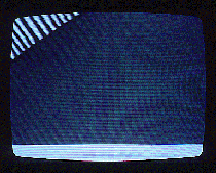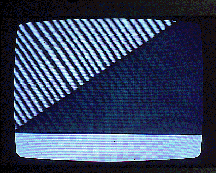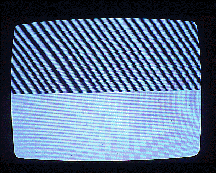| nomads | | gallery entrance | | past exhibitions | | home |



Paulo Laurentiz, four frames from Untitled, slow-scan TV transmission, 1986. ________________________________________________________________ In the pre-Internet days, artists worldwide created their own parallel networks employing low-cost telematic media. One such medium was slow-scan television, which enabled artists to send color video frames over regular telephone lines. Each video image was scanned from top to bottom, line by line. Each image would take from 8 to 12 seconds to be completed, depending on the amount of information contained in the image. Brazilian artist Paulo Laurentiz (1953--1991) was a pioneer of telecommunications art who explored multiple media, including video, fax, slow-scan TV and videotext. A summary of his work can be found in his book A Holarquia do Pensamento Artístico, published by Editora da Unicamp, São Paulo, in 1991. One key element of the aesthetic of slow-scan television was the gradual formation of the image. In collaboration with other artists, Laurentiz created the piece shown here, which explored this feature in unique ways. As Laurentiz transmitted his images, the artists in remote space saw on their screens oblique lines that became longer as new frames came in. At the same time, a horizontal white bar at the bottom of the screen became incrementally larger. This piece suggested natural processes as the white oblique lines (evocative of rain) merged with the white area at the bottom (evocative of the ocean), filling the black screen with white. For more information, contact Silvia Laurentiz Rua Gabrielle D'Annúnzio, 518 São Paulo, SP, 04619-001 Brazil Tel./Fax: 55-11-241-2513
| nomads | | gallery entrance | | past exhibitions | | home |